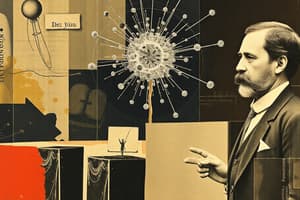Podcast
Questions and Answers
Which of the following observations is inconsistent with Redi's findings?
Which of the following observations is inconsistent with Redi's findings?
- Maggots formed in the uncovered jars.
- Maggots did not form in the tightly sealed jars.
- Maggots formed on top of the gauze in the gauze-covered jars.
- Maggots formed in the gauze-covered jars. (correct)
If 'spontaneous generation' were true, which of the following would Pasteur have observed in his swan-neck experiment?
If 'spontaneous generation' were true, which of the following would Pasteur have observed in his swan-neck experiment?
- The sterile broth would have been contaminated only when the swan-neck was broken.
- The sterile broth would have been contaminated whether or not the swan-neck was intact or broken. (correct)
- The sterile broth would not have been contaminated whether or not the swan-neck was intact or broken.
- The sterile broth would have been contaminated only when the swan-neck was intact.
Which of the following could have explained Needham's experimental result knowing 'spontaneous generation' is not true? Check all that apply.
Which of the following could have explained Needham's experimental result knowing 'spontaneous generation' is not true? Check all that apply.
- Needham could have introduced microbes while sealing the flasks. (correct)
- New microbes have arisen spontaneously from the boiled broth.
- Needham may not have sealed the flasks properly. (correct)
- Needham likely did not boil the broth enough to kill all the microbes. (correct)
If 'spontaneous generation' were true, which of the following would Redi have observed in his meat jar experiment? Check all that apply.
If 'spontaneous generation' were true, which of the following would Redi have observed in his meat jar experiment? Check all that apply.
Which of the following is correct about Pasteur's swan-neck flask experiment? Check all that apply.
Which of the following is correct about Pasteur's swan-neck flask experiment? Check all that apply.
What was Louis Pasteur's contribution to the germ theory?
What was Louis Pasteur's contribution to the germ theory?
Which of the following are supporting evidence of the endosymbiotic theory? Check all that apply.
Which of the following are supporting evidence of the endosymbiotic theory? Check all that apply.
Which of the following is not a part of the cell theory?
Which of the following is not a part of the cell theory?
Before the germ theory was developed in the 1800s, what was the prevailing theory to explain what causes diseases?
Before the germ theory was developed in the 1800s, what was the prevailing theory to explain what causes diseases?
Why do scientists think that the evolution of mitochondria happened before the evolution of chloroplasts?
Why do scientists think that the evolution of mitochondria happened before the evolution of chloroplasts?
Which of the following statements about endospores is correct? Check all that apply.
Which of the following statements about endospores is correct? Check all that apply.
Study Notes
Spontaneous Generation and Experiments
- Francesco Redi's 1668 experiment aimed to disprove spontaneous generation by using meat in different containers.
- Observations showed that maggots formed in open jars and uncovered jars, but not in tightly sealed jars, suggesting maggots do not arise spontaneously.
- John Needham's experiment in 1745 supported spontaneous generation; however, improper sealing and insufficient boiling could explain cloudy broth results.
- Needham's findings are contradicted by proper scientific controls, which demonstrated flaws in his methodology.
Pasteur's Swan-Neck Experiment
- Louis Pasteur's swan-neck flask experiment provided crucial evidence against spontaneous generation.
- Sterile broth remained uncontaminated when the flask’s neck was intact, supporting the idea that airborne microbes are responsible for contamination.
- Contamination occurred only when the swan-neck was broken, allowing air and microbes to enter.
Contributions to Germ Theory
- Pasteur suggested that microbes cause infection, emphasizing a link between microbes, food spoilage, and disease.
- The germ theory has foundational principles that tie specific microbes to specific diseases.
Endosymbiotic Theory
- Mitochondria and chloroplasts support the endosymbiotic theory through several characteristics:
- Both organelles possess their own DNA and circular genomes.
- They contain unique ribosomes and reproduce independently via binary fission.
Cell Theory Insights
- Key tenets of cell theory include:
- Cells are the basic units of life.
- All living organisms are made up of cells.
- All cells arise from pre-existing cells.
- An important distinction is that not all cells use DNA as genetic material, which is contrary to cell theory.
Historical Theories of Disease
- Before germ theory emerged in the 1800s, the prevailing belief was the miasma theory, positing that diseases arose from "bad air" or "miasmas."
Evolution of Organelles
- The evolution of mitochondria likely preceded that of chloroplasts because all eukaryotic cells possess mitochondria, while only some have chloroplasts.
Endospores Characteristics
- Endospores are produced by gram-positive bacteria and are dormant structures.
- They possess high calcium content and dipicolinic acid, contributing to their resistance to unfavorable environmental conditions.
Studying That Suits You
Use AI to generate personalized quizzes and flashcards to suit your learning preferences.
Description
This quiz covers key concepts from chapters 3 and 4 of the Microbiology 2024 curriculum. It specifically addresses Francesco Redi's experiment on spontaneous generation and the observations related to maggot formation. Test your understanding and retention of these foundational microbiology principles.




